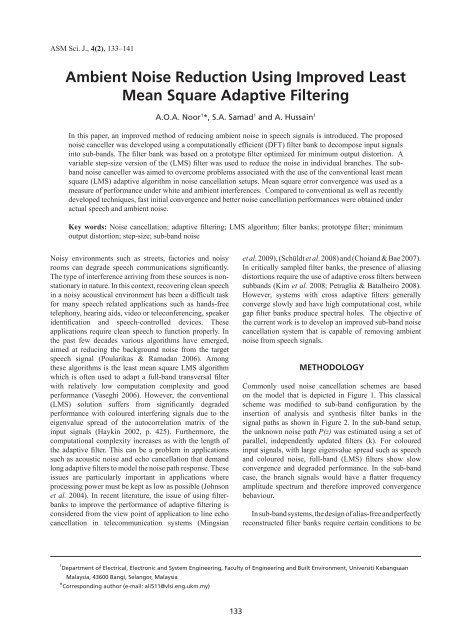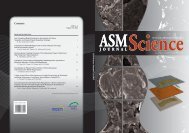contents - Akademi Sains Malaysia
contents - Akademi Sains Malaysia
contents - Akademi Sains Malaysia
- No tags were found...
Create successful ePaper yourself
Turn your PDF publications into a flip-book with our unique Google optimized e-Paper software.
ASM Sci. J., 4(2), 133–141Ambient Noise Reduction Using Improved LeastMean Square Adaptive FilteringA.O.A. Noor 1 *, S.A. Samad 1 and A. Hussain 1In this paper, an improved method of reducing ambient noise in speech signals is introduced. The proposednoise canceller was developed using a computationally efficient (DFT) filter bank to decompose input signalsinto sub-bands. The filter bank was based on a prototype filter optimized for minimum output distortion. Avariable step-size version of the (LMS) filter was used to reduce the noise in individual branches. The subbandnoise canceller was aimed to overcome problems associated with the use of the conventional least meansquare (LMS) adaptive algorithm in noise cancellation setups. Mean square error convergence was used as ameasure of performance under white and ambient interferences. Compared to conventional as well as recentlydeveloped techniques, fast initial convergence and better noise cancellation performances were obtained underactual speech and ambient noise.Key words: Noise cancellation; adaptive filtering; LMS algorithm; filter banks; prototype filter; minimumoutput distortion; step-size; sub-band noiseNoisy environments such as streets, factories and noisyrooms can degrade speech communications significantly.The type of interference arriving from these sources is nonstationaryin nature. In this context, recovering clean speechin a noisy acoustical environment has been a difficult taskfor many speech related applications such as hands-freetelephony, hearing aids, video or teleconferencing, speakeridentification and speech-controlled devices. Theseapplications require clean speech to function properly. Inthe past few decades various algorithms have emerged,aimed at reducing the background noise from the targetspeech signal (Poularikas & Ramadan 2006). Amongthese algorithms is the least mean square LMS algorithmwhich is often used to adapt a full-band transversal filterwith relatively low computation complexity and goodperformance (Vaseghi 2006). However, the conventional(LMS) solution suffers from significantly degradedperformance with coloured interfering signals due to theeigenvalue spread of the autocorrelation matrix of theinput signals (Haykin 2002, p. 425). Furthermore, thecomputational complexity increases as with the length ofthe adaptive filter. This can be a problem in applicationssuch as acoustic noise and echo cancellation that demandlong adaptive filters to model the noise path response. Theseissues are particularly important in applications whereprocessing power must be kept as low as possible (Johnsonet al. 2004). In recent literature, the issue of using filterbanksto improve the performance of adaptive filtering isconsidered from the view point of application to line echocancellation in telecommunication systems (Mingsianet al. 2009), (Schüldt et al. 2008) and (Choiand & Bae 2007).In critically sampled filter banks, the presence of aliasingdistortions require the use of adaptive cross filters betweensubbands (Kim et al. 2008; Petraglia & Batalheiro 2008).However, systems with cross adaptive filters generallyconverge slowly and have high computational cost, whilegap filter banks produce spectral holes. The objective ofthe current work is to develop an improved sub-band noisecancellation system that is capable of removing ambientnoise from speech signals.METHODOLOGYCommonly used noise cancellation schemes are basedon the model that is depicted in Figure 1. This classicalscheme was modified to sub-band configuration by theinsertion of analysis and synthesis filter banks in thesignal paths as shown in Figure 2. In the sub-band setup,the unknown noise path P(z) was estimated using a set ofparallel, independently updated filters (k). For colouredinput signals, with large eigenvalue spread such as speechand coloured noise, full-band (LMS) filters show slowconvergence and degraded performance. In the sub-bandcase, the branch signals would have a flatter frequencyamplitude spectrum and therefore improved convergencebehaviour.In sub-band systems, the design of alias-free and perfectlyreconstructed filter banks require certain conditions to be1 Department of Electrical, Electronic and System Engineering, Faculty of Engineering and Built Environment, Universiti Kebangsaan<strong>Malaysia</strong>, 43600 Bangi, Selangor, <strong>Malaysia</strong>* Corresponding author (e-mail: ali511@vlsi.eng.ukm.my)133paper 4.indd 1331/20/2011 11:24:46 AM

















